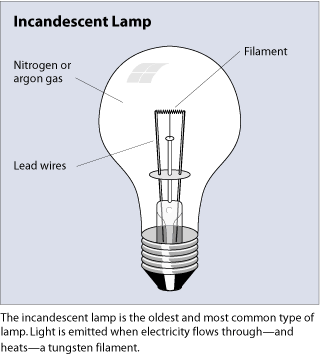incandescent lighting

Incandescent lighting is the most common type of lighting used in homes. It has traditionally delivered about 85% of household illumination.
Incandescent lamps operate without a ballast. They light up instantly, providing a warm light and excellent color rendition. You can also dim them. However, incandescent lamps have a low efficacy compared to other lighting options (10–17 lumens per watt) and a short average operating life (750–2500 hours).
Incandescent lamps are the least expensive to buy, but because of their relative inefficiency and short life spans, they usually are more expensive to operate.
Types of incandescent lamps
These are the three most common types of incandescent lamps:
You can use the chart below to compare these types of lamps. If you don't already, it helps to understand basic lighting principles and terms before making comparisons.
| incandescent lighting type | efficacy (lumens/watt) |
lifetime (hours) |
color rendition index (CRI) | color temperature (K) |
indoors/outdoors |
| standard 'A' bulb | 10–17 | 750–2500 | 98–100 (excellent) | 2700–2800 (warm) | indoors/outdoors |
| tungsten halogen | 12–22 | 2000–4000 | 98–100 (excellent) | 2900–3200 (warm to neutral) | indoors/outdoors |
| reflector | 12–19 | 2000–3000 | 98–100 (excellent) | 2800 (warm) | indoors/outdoors |
